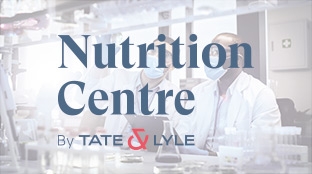Childhood is a period of growth and development and having a healthy diet is essential. Among the nutrients that are important for child development is fibre. It benefits gut health, helping to support normal bowel function, maintain healthy blood glucose and lipid levels and may contribute to feeling full.
According to the World Health Organization, adults should consume a minimum of 25g of fibre a day, with additional benefits at over 29g per day.1 For children, recommendations are usually defined according to age groups, but a consumption of dietary fibre according to the general “age + 5” rule, is also a good rule of thumb. This means children should consume a daily amount of fibre equal to their age plus five grams of dietary fibre from diverse sources.
Research indicates that fibre consumption globally is below official recommendations. Therefore, strategies to ensure adequate intake through whole foods, nutrition education, and the development of fibre-rich products are urgent and essential, especially in childhood, when healthy lifestyle habits are formed.
National data shows that dietary fibre intake is inadequate in most US children, especially from low-income and minority backgrounds, with an average intake of 7-9g per day among toddler-aged children (1–2 years) and 10–11.5g per day among preschool-aged children (3–5 years).2,3 In Europe, the intake of fibre also remains low. For example, in the UK, only 2% of girls and 6% of boys aged 11-18 years meet fibre guidelines. Only 9-10% of children aged 4-10 years achieve the daily fibre recommendations.4
To explore ways to combat this fibre gap, Tate & Lyle and Nestlé joined forces to develop a Technical Opinion on polydextrose use in children. Below we outline some of the top line findings and takeaways from the paper – which can be read in full here.
Strategies to increase fibre consumption in children
To ensure an adequate intake of dietary fibre, it is important to encourage children to eat a healthy and balanced diet. These are some ways to increase fibre consumption among children:
- Offer food rich in fruits and vegetables
- Offer variety - the more colourful, the better
- Get creative with vegetable presentation – not all children like to eat vegetables, so the presentation can be key
- Choose whole foods when possible
Fibre fortification and enrichment
Fibre-fortified foods can help achieve a more adequate intake of fibre, with a physiological effect similar to fibre naturally present in foods. Below are some examples of how fibre-fortified foods can be included in the child’s diet:
- At main meals prepare recipes with fibre-fortified milk and/or flour
- Choose fibre-rich cereals, such as oats, or cereals that contain added fibre
- Offer fibre fortified milk, 100% juices or fibre-fortified juices instead of juice drinks with added sugar
- Choose wholegrain cookies, cakes or pies made with fibre-fortified flour
- Lastly, fibre supplements can be used. Powder forms can be mixed with foods or beverages, maintaining taste while increasing the amount of fibre in the food
Recognising fibre sources in fortified foods and beverages
Reading the ingredient list on packaging is essential, as it gives an overview of everything contained in the food or beverage. The ingredient list may use technical terminology for the sources of fibre present in the food or drink. These terms are defined and mandated by regulatory authorities; however, they are often unfamiliar to the public. Polydextrose is one such example.
What is polydextrose?
Polydextrose is a digestion-resistant polymer (non-digestible carbohydrate), whose caloric value is 1 kcal/g.5 Classified as soluble dietary fibre, it is considered a functional ingredient as it is not hydrolysed by digestive enzymes, is partially fermented in the large intestine, and is largely excreted in the faeces.6
What are the benefits of Polydextrose?
Polydextrose has many benefits:
- Polydextrose can reduce the caloric value of foods when it is used to replace glycemic carbohydrates such as sucrose.7
- Polydextrose has been shown in numerous studies to have positive benefits for supporting healthy bowel function and contribute to improving gut health.
- Polydextrose has physiological effects on the body.8-10 For example, it decreases postprandial glycaemic and insulinaemic responses7, 11 and has a role in prolonging fullness12.
- Polydextrose can stimulate the growth of lactobacilli and bifidobacteria, and fermentation along the colon.13 This gradual fermentation of polydextrose gives rise to moderate amounts of fermentation products such as short-chain fatty acids. These metabolites can reduce the pH of the colon, which can lead to better absorption of minerals, including calcium, magnesium and iron.14
- Polydextrose can be added to infant formulas so that the composition is similar to breast milk, to help support digestion in formula-fed children.15
- Polydextrose has beneficial physiologic effects, and it positively impacts the gut microbiota, therefore it is likely that it acts as a prebiotic.
References
1. WORLD HEALTH ORGANIZATION. Diet, nutrition, and prevention of chronic diseases. Report of a WHO/FAO expert consultation. In: WHO Tech. Rep. Ser. 916, pp. 1–149, 2003.
2. WILSON TA, ADOLPH AL, BUTTE NF. Nutrient adequacy and diet quality in non-overweight and overweight Hispanic children of low socioeconomic status: the Viva la Familia Study. J Am Diet Assoc. 2009;109:1012–21
3. FINN, K.; JACQUIER, E.; KINEMAN, B.; STORM, H.; CARVALHO, R. Nutrient intakes and sources of fibre among children with low and high dietary fibre intake: the 2016 feeding infants and toddlers study (FITS), a cross-sectional survey. BMC Pediatr, 18, 19 (1), p. 446, Nov. 2019.
4. NDNS (2018) Results of the National Diet and Nutrition Survey (NDNS) rolling programme for 2014 to 2015 and 2015 to 2016, available at https://www.gov.uk/government/statistics/ndns-results-from-years-7-and-8-combined
5. STUMM I.; BALTES W. Analysis of the linkage positions in polydextrose by the reductive cleavage method. Food Chemistry, 59, p. 291–297, 1997.
6. ACHOUR, L.; FLOURIE, B.; BRIET, F.; et al. Gastrointestinal effects and energy value of polydextrose in healthy nonobese men. Am J Clin Nutr, 59, p. 1362-1368, 1994.
7. FLOOD, M. T.; AUERBACH, M. H.; CRAIG, S. A. A review of the clinical toleration studies of polydextrose in food. Food Chem Toxicol. 42 (9), p. 1531-42, Sep. 2004.
8. GOVERS, M. J. A. P.; GANNON, N. J.; DUNSHEA, F. R.; GIBSON, P. R.; MUIR, J. G. Wheat bran affects the site of fermentation of resistene starch and luminal indexes related to colon cancer risk: A study in pigs. Gut, 45, 840-847, 1999.
9. DO CARMO, M. M., WALKER, J. C., NOVELLO, D., CASELATO, V. M., SGARBIERI, V. C., OUWEHAND, A. C., ANDREOLLO, N. A., HIANE, P. A., & DOS SANTOS, E. F. (2016). Polydextrose: Physiological Function, and Effects on Health. Nutrients, 8 (9), 553.
10. DRIS, R.; GASPERI, J.; ROCHER, V.; TASSIN, B. Synthetic and non-synthetic anthropogenic fibres in a river under the impact of Paris Megacity: Sampling methodological aspects and flux estimations. Sci Total Environ., 15, 618, p. 157-164, Mar. 2018.
11. CHANDALIA, M.; GARG, A.; LUTJOHANN, D.; et al. Beneficial Effects Of High Dietary Fibre Intake In Patients With Type 2 Diabetes Mellitus. The New England Journal of Medicine, May, 2000.
12. PARKMAN, H. P.; HALLINAN, E. K.; HASLER, W. L.; FARRUGIA, G.; KOCH, K. L.; et al. Early satiety and postprandial fullness in gastroparesis correlate with gastroparesis severity, gastric emptying, and water load testing. Neurogastroenterology & Motility, 29 (4), e12981, 2016.
13. IE, Z.; BANGYAO, L.; MINGJIE X, et al. Studies on the effects of polydextrose intake on physiologic functions in Chinese people. Am J Clin Nutr., 72:1503-9, 2000.
14. RÖYTIÖ, H.; OUWEHAND, A. C. The fermentation of polydextrose in the large intestine and its beneficial effects. Benef Microbes. 5 (3), p. 305-13, Sep. 2014.
15. VANDENPLAS, Y.; DE RONNE, N.; VAN DE SOMPEL, A.; HUYSENTRUYT, K.; ROBERT, M.; RIGO, J.; SCHEERS, I.; BRASSEUR , D.; GOYENS, P. A Belgian consensus-statement on growing-up milks for children 12–36 months old. European. Journal of Pediatrics, 173 (10), p. 1365–1371, 2014.

Nutrition plays a key role in consumers’ lives
We address the health and nutritional needs of your consumers using our science-based innovative ingredient solutions. Discover how in our Nutrition Centre...
